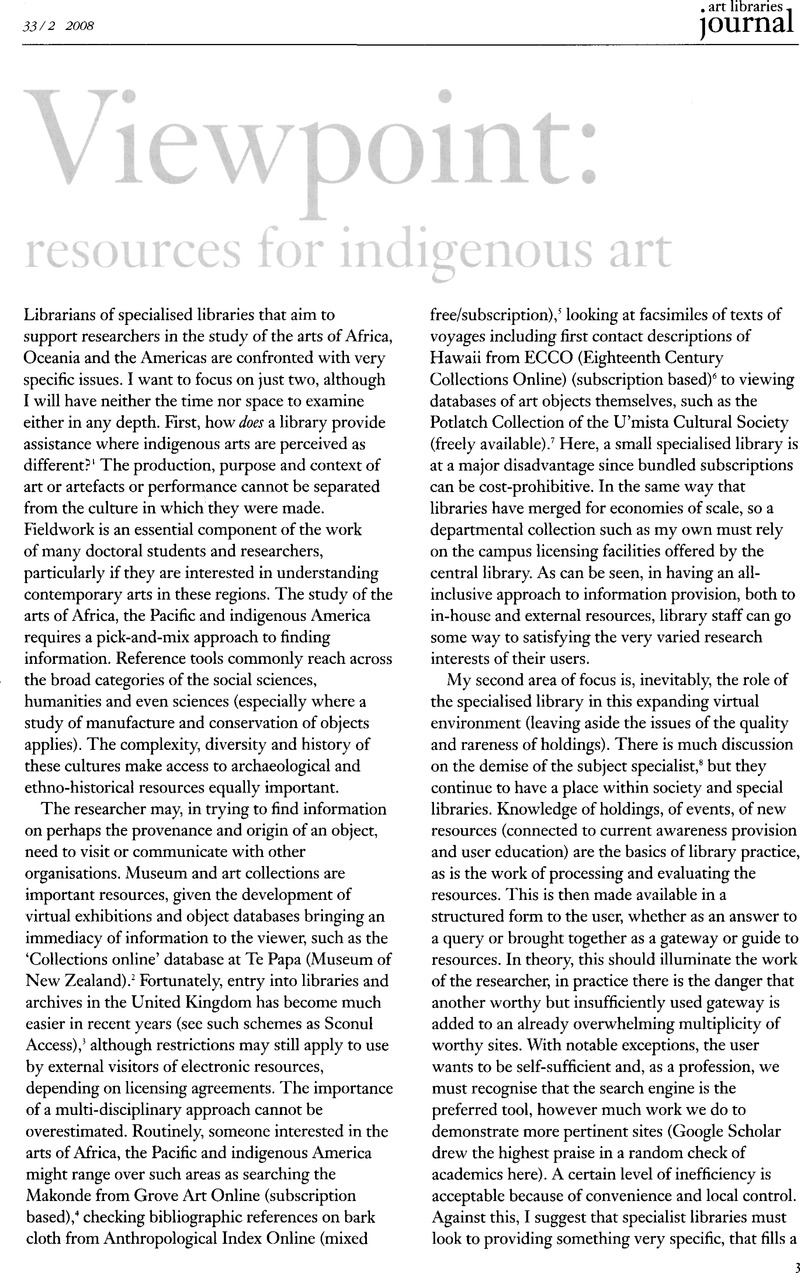No CrossRef data available.
Article contents
Viewpoint: resources for indigenous art
Published online by Cambridge University Press: 06 June 2016
Abstract
An abstract is not available for this content so a preview has been provided. Please use the Get access link above for information on how to access this content.

- Type
- Other
- Information
- Art Libraries Journal , Volume 33 , Issue 2: Special Issue on documenting indigenous and minority art , 2008 , pp. 3 - 4
- Copyright
- Copyright © The Art Libraries Society 2008
References
1. I am aware that use of the term ‘indigenous art’ with ‘difference’ is a contentious issue. For example, if setting up an exhibition of contemporary artists, why should say an African artist, an artist of African descent or a European artist be viewed, or their work displayed, differently?Google Scholar
2. Te Papa collections online, http://collections.tepapa.govt.nz/objectsearch.aspx/. There is the wider issue of access to these online resources within non-industrialised indigenous societies themselves because of both financial and technical constraints.Google Scholar
6. Eighteenth century collections online, http://gale.cengage.com/EighteenthCentury/index.htm.Google Scholar
8. See for example the articles by Houghton, Beth and Volker, Joye in the Art libraries journal
31, no.2 (2006).Google Scholar
9. For another example, see the blog of the Robert Goldwater Library, Metropolitan Museum of Art, New York which provides information on events and issues relating to indigenous arts, http://goldwaterlibrary.typepad.com/.Google Scholar
10. Wider in scope than the visual arts, the IFLA (International Federation of Library Associations and Institutions) statement on Indigenous Traditional Knowledge is of note. It seeks to broaden what is often a negative debate on issues of access and control of knowledge, to one of local empowerment and development of mutual respect between a researcher and the indigenous community. In particular see the bullet point that recommends that libraries and archives ‘Publicize the value, contribution, and importance of indigenous and local traditional knowledge to both non-indigenous and indigenous peoples’, http://www.ifla.org/III/eb/sitk03.html. For a local viewpoint on this issue, again broadly based but relevant to the visual arts, see Vilimaina Vakaciwa, ‘Preserving and managing traditional knowledge of the Pacific: what we know and what we can do?’ in PIALA 2004 14th annual conference proceedings; and PIALA 2005 15th annual conference proceedings: selected papers from the 14th and 15th Pacific Islands Association of Libraries and Archives annual conferences, ed. by Cohen, Arlen (Guam: Pacific Islands Association of Libraries and Archives, 2006), http://www.uog.edu/rfk/piala/proceedings/PIALA2004-05.pdf. For an example in practice, see the Australian Institute of Aboriginal and Torres Islander Studies (AIATSIS) which has established rigorous guidelines regarding research which informs use of the library and archives, http://www.aiatsis.gov.au/library/.Google Scholar


